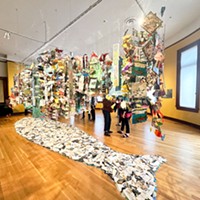[
{
"name": "Top Stories Video Pair",
"insertPoint": "7",
"component": "17087298",
"parentWrapperClass": "fdn-ads-inline-content-block",
"requiredCountToDisplay": "1"
}
]
It all started with two 4-by-4-by-4-foot boxes of wood wool — great piles of curly, hay-like wood shavings — marked "FREE" outside Miller Farms Garden Center. Artist Becky Evans saw the boxes and thought her friend and fellow artist Lori Goodman might want to use the material in her paper-making practice. Eventually, they transformed the material into PLAY, a color drenched, provocatively tactile, immersive installation in Goodman's Eureka barn.
When Goodman initially saw the volume of material Evans had secured for her, she told Evans it was too much, telling her, "Take it back!" Instead of going back to the garden center, however, the wood wool sat in Goodman's barn for about a year.
Then one day, on a whim, Goodman began coloring the wood wool with the dyes she was using for her paper. She discovered the shredded wood fiber, also known as excelsior — a biodegradable packing material, often used in pet bedding and gift baskets — took the dyes exceptionally well. Over the course of some months, with Evans' help, the boxes of discarded packing material became mounds of curly, vivid, color-stuff.
Evans' and Goodman's original plan for the stuff was to make some kind of sculptural installation in a field. During the dying process, however, they brought some of the colored wood wool into the barn to dry and realized they had already created a huge installation on the floor. They began to play. Their artistic play was intuitive, spontaneous and free from deadlines. "If it wasn't fun," Evans says, "It wasn't something we wanted to do."
The artists experimented with crafting bundles, and with developing visual contrasts and counterpoints, moving the material around. The whole process, they say, was based on "discovery." Ultimately, they learned the excelsior lent itself to being hung on the walls with finishing nails. Over time, Evans and Goodman covered the four walls of the barn, edge to edge, from overhead down to the ground.
The installation, which opened to public viewing during Open Studios, demands to be touched and offers sensory contradictions. Its material looks fluffy but feels rough. It appears as though it might be dangerous, possessing some visual qualities of fiberglass and asbestos, but is in fact entirely safe and earth-friendly. Colors blend to form gradients around the four structural surfaces, leading to a rich, dark, purple and black field along the back wall. The installation calls to mind celestial associations, which are reinforced by bright wrapped forms that dangle from above like an enlarged mobile in the center of the room and operate like space objects contrasting against the black backdrop when viewed from the entrance.
The hanging sculptural forms and the regions of alternating colors on the walls invoke the style of early 20th century German-Swill abstract painter Paul Klee, with casual geometric shapes made of smooth edges calling to mind nature and music above mathematics. PLAY's color blobs look amoebic, like they want to — but don't quite — become pictorial, and sometimes roll themselves up into balls.
Though it is comprised of wood wool, the wall-mounted part of the installation actually operates like a huge, hinged, four-panel abstract painting. Swaths of color act like big brush strokes, evidencing the materiality of the wood shavings and the breadth of the artists' arm spans. It is playfully meditative. The space inside the installation feels like it is staging for ... something, as though the room is waiting for an event to occur there. The viewer stands inside a giant packing crate that is the barn, in the negative space between the packing materials, where some gigantic fragile object ought to be.
Both Evans and Goodman stress that, as the title suggests, PLAY was entirely intuitive and spontaneous, a diversion from their usual serious themes, conceptual endeavors and deadlines. It is not, however, wholly disconnected from their separate practices. In their individual work, the two artists have weaving in common, working with non-traditional textile arts. They also both regularly construct installations. They say they were excited to make something vibrant and short-lived, and will, upon the completion of the PLAY exhibition, enjoy returning to their own studios.
PLAY will again be open to the public Sunday, June 30 from 10 a.m. to 4 p.m. Get the location and/or make a viewing appointment through July by contacting he artists at loribgoodman.com and beckyevansart.com.
L.L. Kessner is an Arcata-based artist and writer.
Speaking of...
-

The Return of '30,000 Salmon'
Aug 17, 2023 - More »
more from the author
-
Establishing Secure Connection
Kian Rad Pouvan at Epitome Gallery
- May 23, 2024
-
New Art Sellers Around Old Town:
Stock Schlueter Fine Art and 4th Street Mercantile
- Jan 25, 2024
-
Full Circle Journey
Robert Benson's Tintah: Amongst the Trails at the Goudi'ni Native American Arts Gallery
- Oct 26, 2023
- More »
































